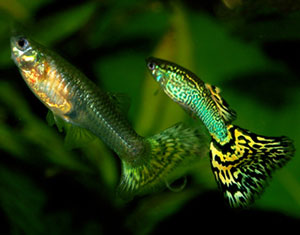Dawkins playing bait and switch with guppy selection

In Dawkins’ new book The Greatest Show on Earth (Transworld, London, 2009), he supposedly presents proof of evolution, as he admits that “the evidence for evolution is nowhere explicitly set out” in his previous books. But much of his book is guilty of the logical fallacy of equivocation or “bait-and-switch”, that is, switching the meaning of a single word (evolution) part-way through an argument. For example, the real point of debate is whether all living things come from pond scum, but Dawkins says:
“ … when there is a systematic increase or decrease in the frequency with which we see a particular gene in a gene pool, that is precisely what we mean by evolution.” (p. 33)
Yet throughout his book, Dawkins rails against “history deniers” or “40 percenters” who deny “evolution”. But if this is what he means by evolution, then I can’t think of anyone who denies it, including the staff at CMI!
Dawkins uses many of the pages in his book to prove that natural selection is a fact. Once again, creationists taught this before Darwin, and it’s an important part of the modern biblical Creation/Fall/Flood/Dispersion model, explaining how creatures adapt to the environment.
However, Dawkins himself compares most examples of natural selection to a human sculptor removing clay, i.e. “chiselling” genes from the gene pool (p. 34). Such changes are in the opposite direction required to turn bacteria into biologists.

Also, creationists have little problem with sexual selection, i.e. the selection of characteristics preferred by the opposite sex in mate choice. This is potentially a strong effect, since only those creatures that find mates can pass on their genes to the next generation. However, it fails to account for the peacock tail, the very thing Darwin invented the theory to explain! It also hindered discovery of an important function for the huge toucan beak: temperature regulation.
Dawkins does set out some good evidence that both natural selection and sexual selection happen, but knocks down a straw man in thinking that this somehow proves particles-to-people evolution or disproves biblical creation. The following is a draft extract from our forthcoming book, The Greatest Hoax on Earth? Refuting Dawkins on Evolution.
Guppies

Dawkins’ colleague Dr John Endler studied many populations of guppies in mountain streams in Trinidad, Tobago and Venezuela. (pp. 133–9).1 Brightly coloured males seem to impress the females, who “sexually selected” such colours. But they stand out to predators, who would “naturally select” against this. As strong support for this, streams with strong predators contain drabber males, while streams with weak predators have more brightly coloured males with larger, gaudier spots.
Endler noticed that the “drab” ones are camouflaged by spots as well, which blend in with the pebbles at the bottoms of their native streams. So he set up experiments in a number of ponds, half with fine gravel and half with coarse. He allowed guppies to breed freely. The number of spots shot up, presumably since only sexual selection was at work.
Then after six months, he left some ponds predator-free; in others, a fairly weak predator (given that no natural stream is really totally predator-free); and in the remaining, he introduced a strong predator, a pike cichlid. In the ponds with weak or no predation, the number of spots continued to rise, as sexual selection was still operating. But in the ponds with the strong predator, the number of spots dropped sharply. Evidently males with lots of spots were easily spotted and devoured, so despite the females’ preferences, they had to be content with the survivors.
Also, Endler found that gravel size made a difference. Both strong and weak predators promoted larger spots in pools with coarse gravel, and smaller spots with finer gravel. This makes sense—the closer spot size matches gravel, the more camouflaged the fish are. But in ponds with no predators, the reverse happened: fine gravel promoted larger spots and coarse gravel smaller. Again, this makes sense—the less camouflaged males stand out better to the females.
Evolution in action?
Dawkins relates a story Endler told about an encounter with a fellow domestic airline passenger. This passenger showed much interest in Endler’s guppy research, and amiably asked what Endler himself calls “excellent questions … indicating that he was enthusiastically and intellectually following the argument.” Yet when this passenger asked what theory underlined the experiments, Endler replied, “It’s called Darwin’s theory of evolution by natural selection.” Then, by Endler’s account, this passenger quit the conversation, which Endler calls, “really tragic”. Dawkins calls this passenger “closed-minded” (p. 133).
But even if this account is unspun, it doesn’t prove what they claim. This passenger might have been very annoyed at Endler’s cheap bait-and-switch. Dawkins commits the same dishonest equivocation when he claims, “It is a spectacular example of evolution before our very eyes.” (p. 139). It might have been better to reply on the lines of, “Indeed, these are most ingenious experiments to support natural selection, a theory known to creationists before Darwin. But do guppies changing into guppies prove that fish evolved into fishermen? The changes don’t show any new features, just different expressions of the same ones.” Yet this type of change, which doesn’t add any new information, is usually the best “evidence” of evolution and alleged disproof of creation that evolutionists can come up with.
Furthermore, it shows that belief in particles-to-people evolution is not necessary to understand real science, including experiments on natural and sexual selection. And clearly belief in creation does not ruin fascination for such science. So Dawkins’ scare-mongering about “history deniers” destroying science education is shown—even by his own account—to be wide of the mark.
Reference
- While Dawkins does not specifically reference his comments about Endler’s research, it’s likely he’s referring to this paper listed in his Bibliography: Endler, J.A., Natural and sexual selection on color patterns in poeciliid fishes, Environmental Biology of Fishes 9:173–190, 1983. Return to text.



Readers’ comments
Comments are automatically closed 14 days after publication.